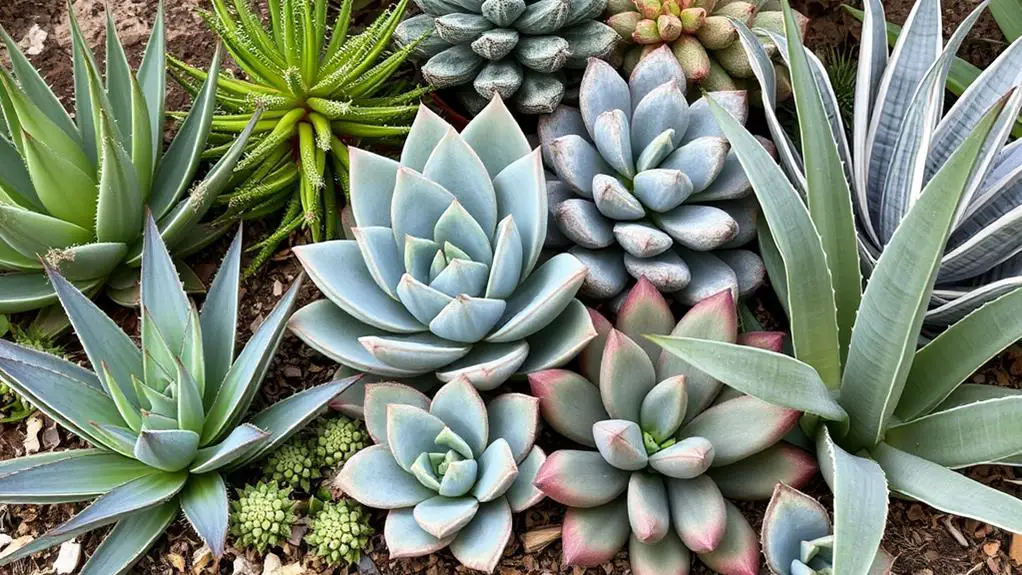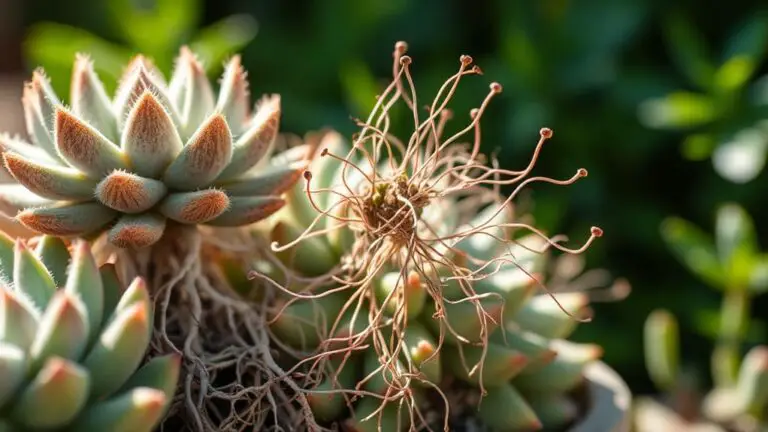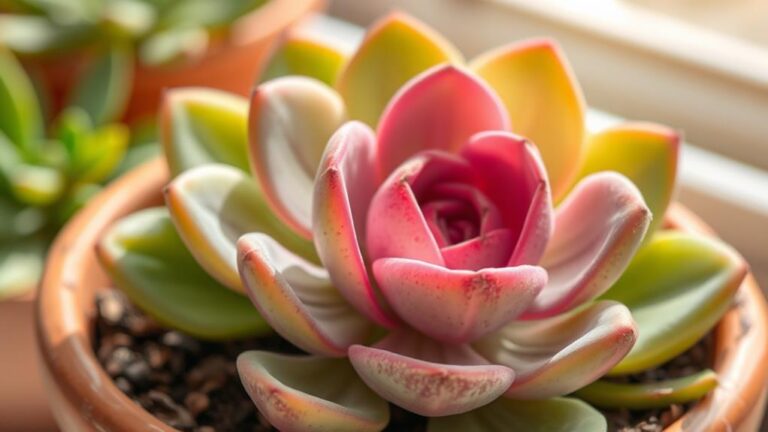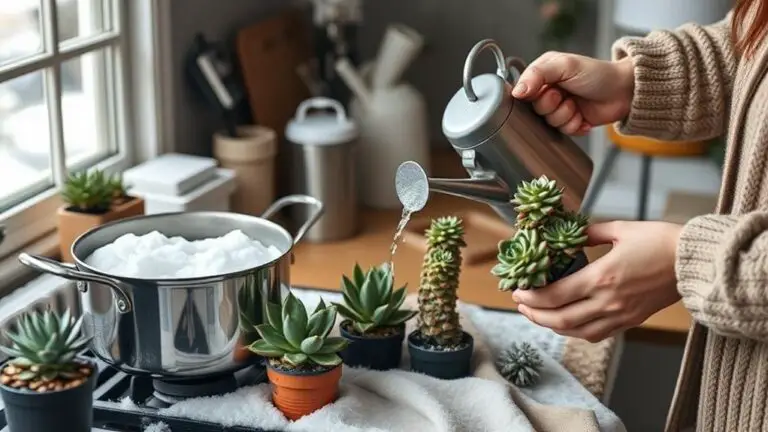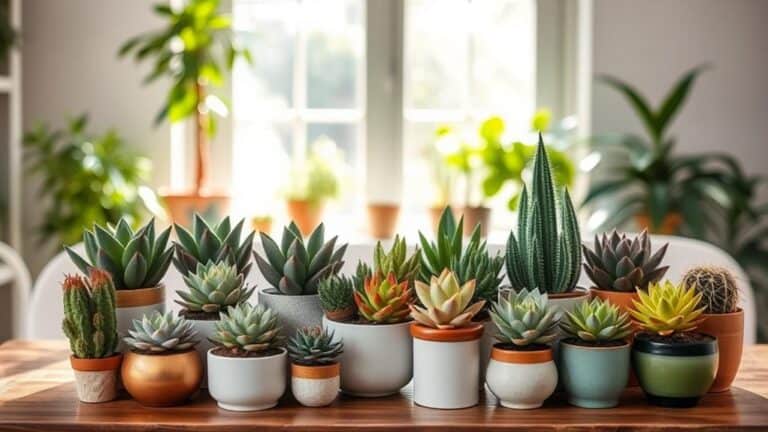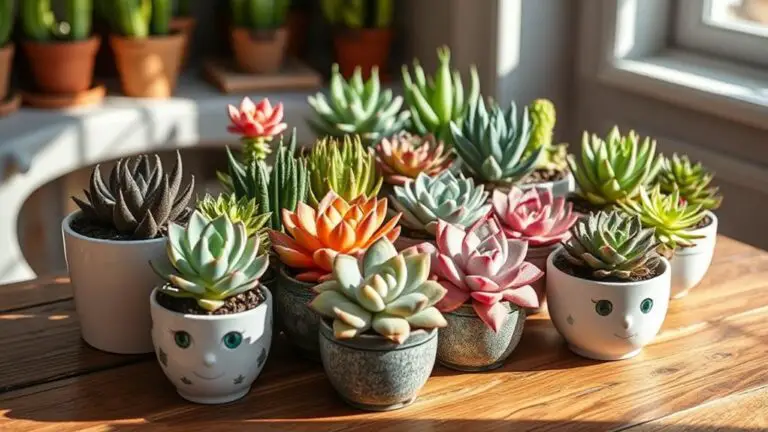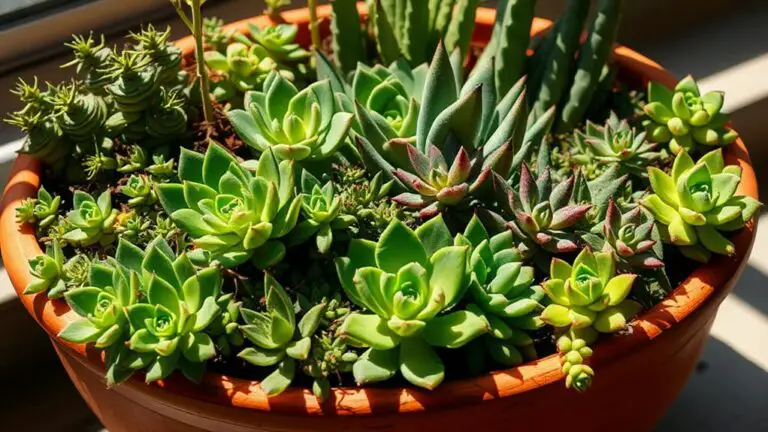Identifying Different Types of Succulents: Part II – Aloe Agave Gasteria and Haworthia
When you're trying to identify different types of succulents, you'll find that Aloe, Agave, Gasteria, and Haworthia each have distinct traits that set them apart. Aloe has fleshy, prickly leaves and blooms annually, making it a common household plant. Agave, on the other hand, features large, spiky leaves and flowers just once in its lifetime, creating a dramatic centerpiece. Gasteria is more compact with speckled, non-spiky leaves, perfect for small spaces. Haworthia stands out with spoon-like leaves adorned with unique stripes. Curious about their specific care needs and how to distinguish them further? Let's explore each one in detail.
Aloe Characteristics
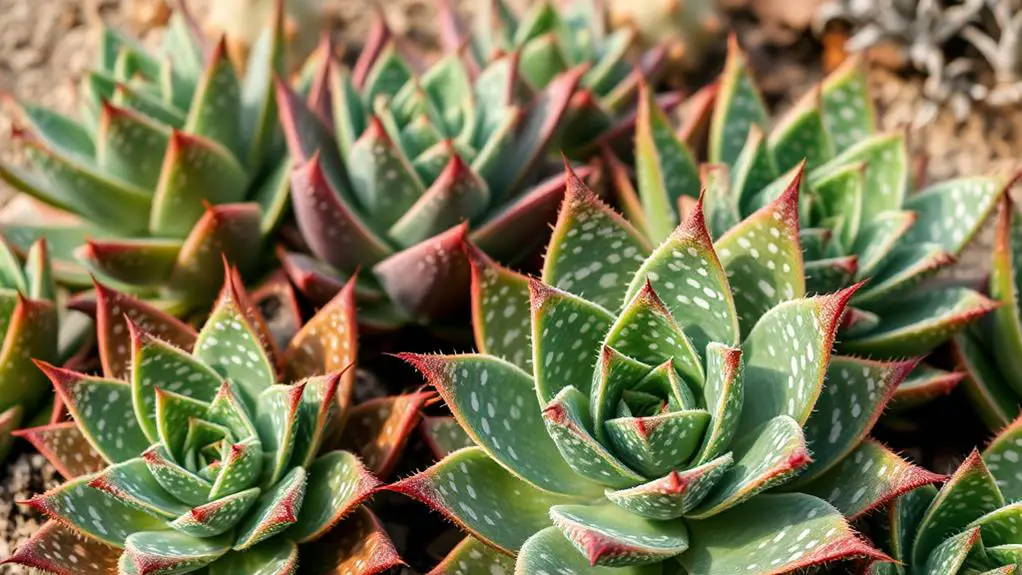
While exploring the diverse world of succulents, you'll quickly notice distinct features that set Aloe plants apart. Aloe plants have thick, fleshy, triangle-shaped leaves that come in shades from light to dark green. These leaves can grow several feet in height and diameter, making them quite striking. The edges of Aloe leaves are adorned with soft prickles, adding to their unique appearance.
Inside the leaves, you'll find a gelatinous, water-filled tissue known for its antioxidant properties. This gel is commonly used in cosmetics, especially for skincare. Aloe blooms annually between December and May, producing beautiful flowers in colors like yellow, orange, and white.
With over 500 species globally, Aloe vera is one of the most popular, celebrated for its medicinal benefits. Aloe plants thrive in well-draining soil, need moderate sunlight, and require infrequent watering. This makes them drought-resistant and perfect for many indoor and outdoor settings.
Whether you're new to gardening or a seasoned pro, Aloe plants are an excellent choice. They're not only easy to care for but also bring a touch of nature's beauty and healing properties into your home.
Agave Features
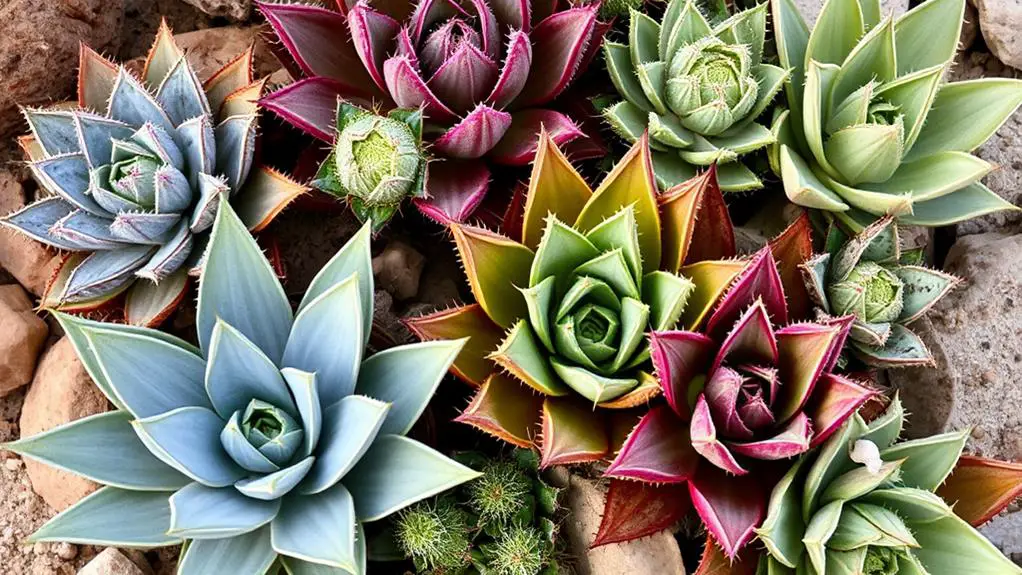
When you look at Agave plants, you'll notice their large, triangle-shaped leaves with sharp spikes along the edges, which can range from just a few inches to an impressive 20 feet in diameter.
These tough leaves are different from other succulents, and Agave blooms just once in its lifetime, usually after 10 to 20 years, producing a tall flowering stalk.
Besides their unique appearance, Agave plants are also useful, especially for making tequila, and they thrive best in sunny, dry climates with well-draining soil.
Leaf Structure and Size
Agave plants boast one of the most striking leaf structures among succulents, with some leaves reaching up to 20 feet in diameter, making them a dominant feature in any garden or landscape. When you look at an Agave, you'll notice its triangular leaves. These leaves are thick and fleshy, designed to store water and help the plant survive in dry environments. The edges of Agave leaves are sharp and spiky, giving them a tough, rugged look that stands out.
To better understand Agave's leaf structure, take a look at this comparison:
| Feature | Agave | Aloe |
|---|---|---|
| Leaf Size | Up to 20 feet in diameter | Few inches to a few feet |
| Edge Texture | Sharp and spiky | Softer, prickly |
| Leaf Interior | Fibrous | Gelatinous and slimy |
If you try the snap test, you'll find Agave leaves are fibrous inside, unlike the gelatinous interior of Aloe leaves. This fibrous tissue adds to their resilience. Agave's bold leaf structure can make a magnificent statement in your garden, while also being practical for arid climates. Enjoy the beauty and strength these unique succulents bring to your space!
Blooming Cycle and Lifespan
With their striking leaf structure covered, let's explore another fascinating aspect of Agave plants: their blooming cycle and lifespan.
Agave plants are monocarpic, meaning they bloom only once in their lifetime. It takes quite a long time—usually between 10 to 20 years—for these resilient plants to mature and reach their blooming cycle.
When an Agave finally decides to flower, it's a spectacular sight. It produces a tall flower spike, which can soar up to 30 feet, and is adorned with clusters of tubular flowers. This blooming cycle typically occurs in the late spring or early summer. The exact timing can vary depending on the species and your local climate conditions.
Unfortunately, after this magnificent display, the Agave plant will die. But don't worry; it's not the end of your Agave garden. Before they perish, Agave plants often produce offsets or "pups." You can use these pups to propagate new plants and keep the cycle going.
The lifespan of Agave plants varies considerably by species. Some can live for several decades before they finally bloom.
Practical Uses and Benefits
You might be surprised to learn just how versatile Agave plants are. These hardy succulents are visually striking, with large, fleshy leaves that can range from a few inches to 20 feet in diameter. This makes them perfect for adding a dramatic touch to your landscaping. If you're interested in succulent identification, Agave's unique appearance certainly makes it stand out.
But Agave isn't just about looks. Did you know that the sap from Agave tequilana is used to make tequila? This highlights its economic importance in the beverage industry. Plus, Agave plants are monocarpic, meaning they bloom only once in their lifetime, usually after 10 to 20 years. This slow growth adds to their mystique and longevity.
Agave leaves also provide strong fibers that can be processed into ropes and textiles. This practical use extends beyond ornamental gardening, showing just how multifunctional these plants can be.
Additionally, Agaves are well-suited for arid regions, thriving in full sun and well-draining soil. This makes them ideal for drought-tolerant gardening, reducing your water usage while still maintaining a beautiful garden.
Gasteria Traits

When identifying Gasteria traits, you'll notice their unique leaf patterns with speckled white stripes and smooth, spikeless edges.
These succulents are perfect for low light conditions, making them great for indoor spaces.
To keep your Gasteria healthy, use well-draining soil and water sparingly, allowing the soil to dry out between waterings.
Unique Leaf Patterns
Ever wondered what sets Gasteria apart from other succulents? The answer lies in their unique leaf patterns. Gasteria leaves are truly distinctive, featuring long, round edges and a thick, fleshy texture. These leaves often display heavily speckled white stripes, creating a striking appearance that's hard to miss.
Unlike succulents like Aloe and Agave, Gasteria leaves are spikeless. This means you won't have to worry about sharp or prickly edges, making them a safer option for homes with pets or children.
Gasteria is also known for its compact size, typically maxing out at around 20 inches. This makes it a fantastic choice for indoor gardening and small spaces. The leaf patterns and textures can vary greatly among the approximately 20 recognized species. Some Gasteria plants have unique stripes, while others may showcase spots, adding to their ornamental value.
These variations in leaf design not only make Gasteria visually appealing but also help you in identifying different species. So, if you're looking for a succulent with a lot of character and minimal maintenance, Gasteria's unique leaf patterns make it an excellent choice.
Low Light Tolerance
Many succulents struggle in low-light conditions, but Gasteria stands out for its impressive adaptability. If you're looking for a plant that thrives indoors or in shaded areas, Gasteria is an excellent choice. Unlike many other succulents that demand bright, direct sunlight, Gasteria can tolerate some shade. This makes it perfect for less-than-ideal lighting situations.
The thick, fleshy leaves of Gasteria are a key feature that helps it manage low light. These leaves store water efficiently, allowing the plant to survive for extended periods without needing direct sunlight.
While Gasterias prefer bright, indirect light, they can still flourish in spots with filtered sunlight or partial shade.
Another benefit is the unique leaf textures and patterns of Gasteria. Not only do these features enhance the plant's aesthetic appeal, but they also contribute to its adaptability in low-light environments.
These traits make Gasteria a versatile plant that can bring life to dimly lit corners of your home or garden.
Watering and Soil Preferences
If you want your Gasteria to thrive, focus on its watering and soil preferences. Gasteria plants need well-draining soil to stay healthy. You can mix in sand or perlite to improve drainage. This helps prevent root rot, a common issue if the soil holds too much water.
When it comes to watering, less is more. Allow the soil to dry out completely between waterings. This mimics the plant's natural habitat, where water is often scarce. Over-watering can harm your Gasteria, so be patient and wait until the soil is dry before giving it more water.
Gasteria also prefers bright, indirect light but can tolerate some shade. This makes it a versatile plant for different indoor spots.
While it's low maintenance, you should still avoid over-fertilizing. During the growing season, a diluted fertilizer can be beneficial, but don't overdo it.
The unique leaf textures and patterns of Gasteria, often featuring stripes or spots, require minimal upkeep. By focusing on proper soil and watering, you'll guarantee your Gasteria stays healthy and vibrant.
Follow these simple tips, and you'll enjoy a thriving plant with little effort.
Haworthia Attributes
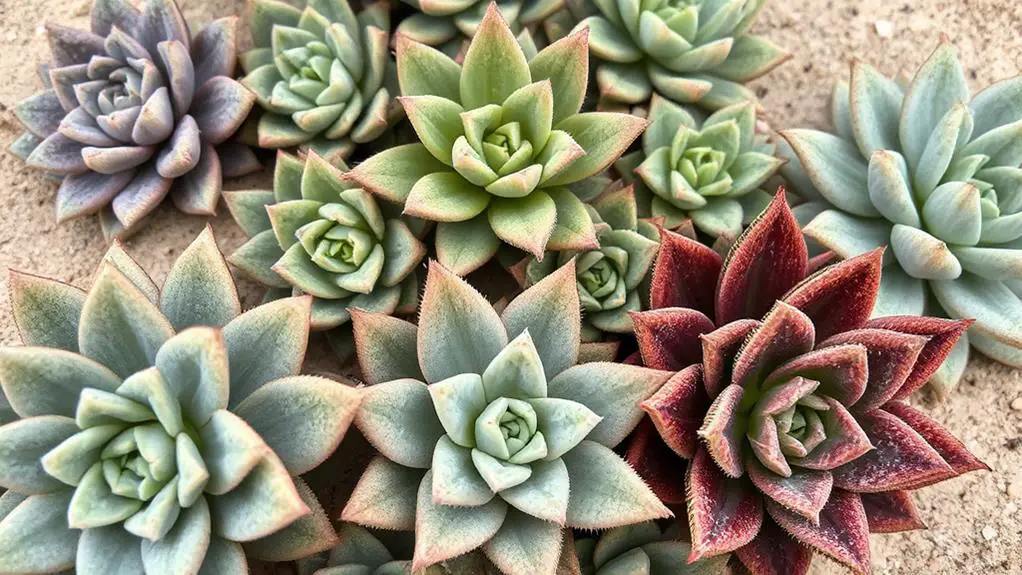
Haworthia species are small, slow-growing succulents that rarely exceed a few inches in diameter, making them perfect for indoor gardening. These charming plants thrive in low light conditions, making them ideal for your home or office space.
You'll love their unique appearance, characterized by round, spoon-like leaves that are densely stacked. These leaves often showcase pale green colors with darker vertical stripes or bumpy white bands, adding a touch of nature's artistry to any room.
Unlike Aloe and Agave, Haworthia species have smooth leaf margins, setting them apart from other succulents. This makes them easier to handle and more aesthetically pleasing.
They're also very adaptable, thriving in various soil types and requiring only moderate watering and infrequent fertilization. With around 70 recognized species, there's a lot of variety to choose from, each with its own leaf patterns and colors.
Here are some key attributes to remember:
- Size: Small and manageable, ideal for indoor spaces.
- Appearance: Spoon-like leaves with unique stripes or bands.
- Care: Adaptable to different soils, moderate watering.
- Variety: Approximately 70 species with diverse patterns.
Caring for Haworthia is straightforward, making it a great choice for beginners and experienced gardeners alike.
Succulent Leaf Differences
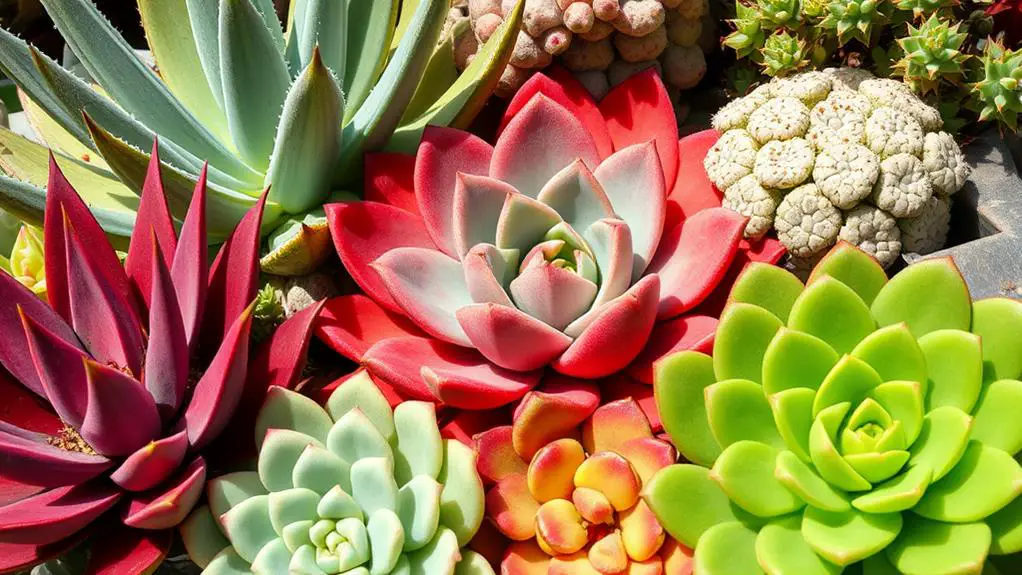
Understanding the differences in succulent leaves can greatly enhance your ability to identify and care for these unique plants. Each type of succulent has distinct leaf characteristics that can help you recognize and differentiate between succulent varieties.
Aloe leaves are thick, fleshy, and triangle-shaped. They often have soft prickles along the edges. When you touch them, you'll notice a gelatinous texture due to their water-filled tissue.
Agave leaves, in contrast, are larger and tougher. They've sharp spikes along the edges. You can confirm their identity by performing a fibrous snap test.
Gasteria leaves stand out with their long, round-edged shape and heavy speckling with white stripes. Unlike Aloe and Agave, Gasteria leaves lack spikes, making them easy to identify.
Haworthia leaves are generally small, round, and spoon-like. They've smooth margins and often display pale green colors with darker vertical stripes. Some varieties may have thick, dark green pointy leaves with bumpy white bands.
Observing these differences in leaf shape, size, and edge characteristics will help you classify and care for your succulents more effectively. Recognizing these succulent varieties guarantees you provide the right environment and care for each plant.
Flowering Patterns
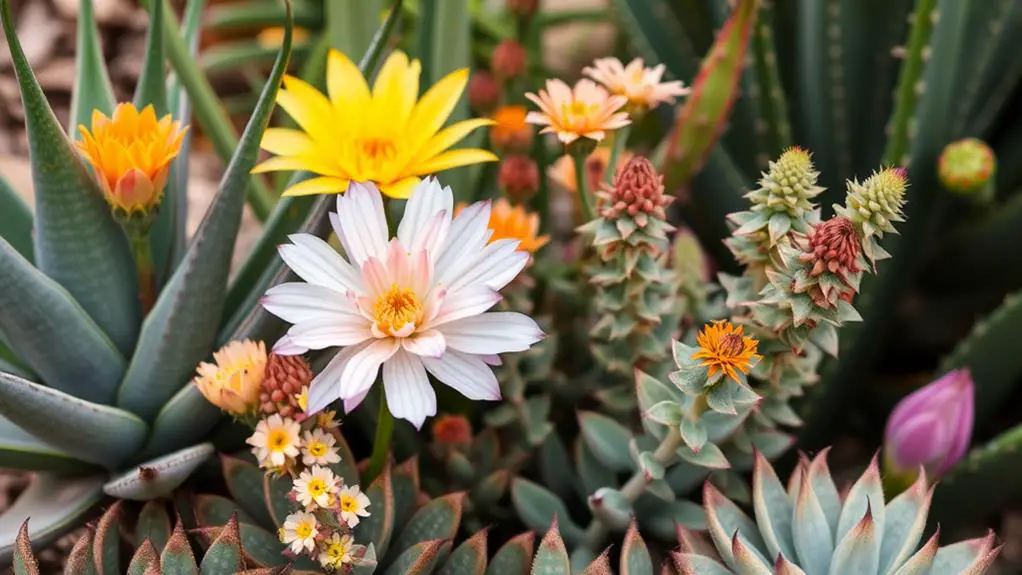
The allure of succulents often lies in their unique flowering patterns. When you're growing Aloe, Agave, Gasteria, or Haworthia, understanding their bloom habits can enhance your gardening experience.
Aloe plants bloom annually between December and May. They produce vibrant flowers in yellow, orange, or white, depending on the species. In contrast, Agave is monocarpic, flowering only once after 10 to 20 years, usually resulting in a tall, striking flower spike.
Gasteria's blooms resemble those of Aloe, with tubular flowers that hang down from upright stalks. Haworthia flowers are smaller and more delicate, often appearing in clusters on long stems and varying in color from white to pale green.
To make the most of your succulent's flowering patterns, consider the following tips:
- Monitor Seasonal Changes: Understand that Aloe blooms in winter to spring, while Agave may take decades.
- Provide Ideal Conditions: Confirm your succulents get enough sunlight and proper watering.
- Watch for Flower Spikes: Look for the tall spikes in Agave and Gasteria, and the delicate clusters in Haworthia.
- Enhance Their Environment: Adjust care routines to boost bloom production.
Growth Habits
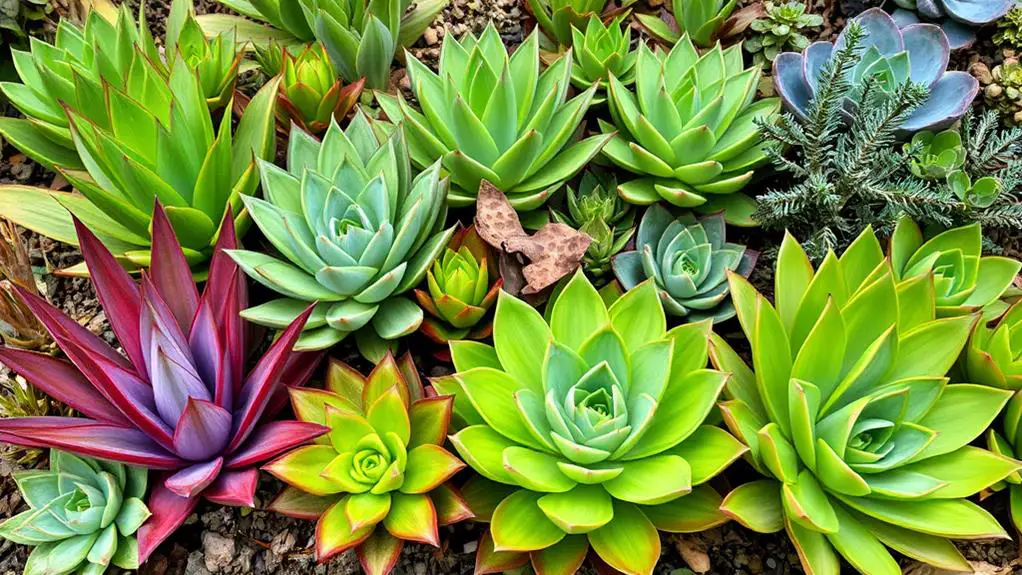
When diving into the growth habits of succulents, it's essential to contemplate each plant's unique characteristics. Aloe, Agave, Gasteria, and Haworthia each have distinct growth patterns that make them special.
Aloe species are polycarpic, meaning they bloom annually from December to May with beautiful Aloe flowers. They are resilient to drought and thrive with less frequent watering. On the other hand, Agave is monocarpic, blooming just once after 10 to 20 years. Agave can grow much larger, some species reaching up to 20 feet in diameter, and it needs full sun and well-draining soil to flourish.
Gasteria, with its thick and fleshy leaves, grows to about 20 inches tall and tolerates shade better than most succulents. Haworthia, staying small at just a few inches in diameter, also adapts well to low light conditions. It grows slowly but steadily, making it perfect for indoor environments.
Here's a handy table to compare their growth habits:
| Succulent | Growth Size | Light Preference |
|---|---|---|
| Aloe | Moderate height | Full sun |
| Agave | Very large | Full sun |
| Gasteria | Up to 20 inches | Shade tolerant |
| Haworthia | Small | Low light adaptable |
Understanding these habits helps you appreciate and care for your succulents better.
Care Requirements
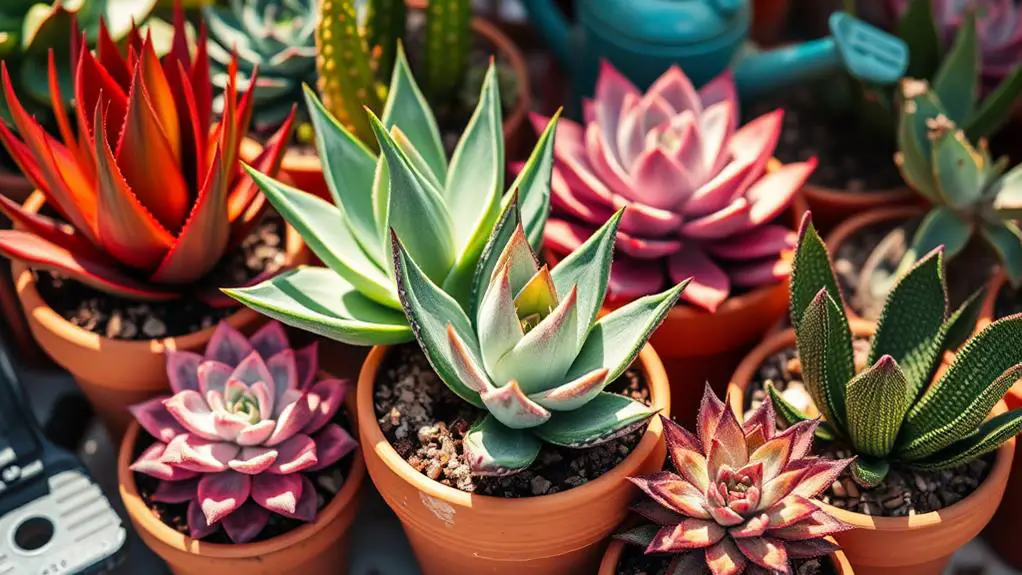
When it comes to caring for your succulents, understanding their soil and watering needs, as well as their light and temperature preferences, is key.
Different types of succulents, like Aloe and Agave, require well-draining soil and specific lighting to thrive.
Soil and Watering Needs
Caring for succulents like Aloe, Agave, Gasteria, and Haworthia involves understanding their distinct soil and watering needs. Each of these plants thrives on the "soak and dry" method, which helps maintain ideal moisture levels and prevents overwatering.
- Aloe: Use well-draining soil, preferably a cactus mix. Water infrequently, letting the soil dry out completely between waterings to avoid root rot.
- Agave: Like Aloe, Agave needs well-draining soil and infrequent watering. This drought-resistant plant thrives in a cactus mix and can suffer if overwatered.
- Gasteria: These plants prefer bright, indirect light and well-draining soil mixed with sand or perlite. Water infrequently, ensuring the soil dries out completely between waterings.
- Haworthia: These adapt well to low light and thrive in well-draining soil. Water moderately, allowing the soil to dry slightly between waterings.
Fertilize occasionally with diluted fertilizer, though it's not necessary.
Light and Temperature Preferences
Understanding the light and temperature preferences of your succulents is essential for their healthy growth. Each type has unique needs to keep them thriving. Let's explore the ideal conditions for Aloe, Agave, Gasteria, and Haworthia.
Aloe prefers bright, indirect light but can handle some direct sunlight. It thrives between 60°F to 80°F. Agave, on the other hand, loves full sun and can withstand temperature extremes, making it perfect for arid climates. Both Aloe and Agave need well-draining soil to prevent root rot.
Gasteria can tolerate lower light conditions compared to other succulents. It prefers bright, indirect light and temperatures between 60°F to 80°F, much like Aloe. Haworthia is perfect for indoor settings since it thrives in low light. It enjoys moderate temperatures, ideally between 60°F to 75°F, and requires well-draining soil to avoid overwatering.
Here's a quick reference table to help you remember their light and temperature preferences:
| Succulent | Light Preference | Temperature Range |
|---|---|---|
| Aloe | Bright, indirect light | 60°F to 80°F |
| Agave | Full sun | Varies widely |
| Gasteria | Bright, indirect light | 60°F to 80°F |
| Haworthia | Low light | 60°F to 75°F |
Common Uses
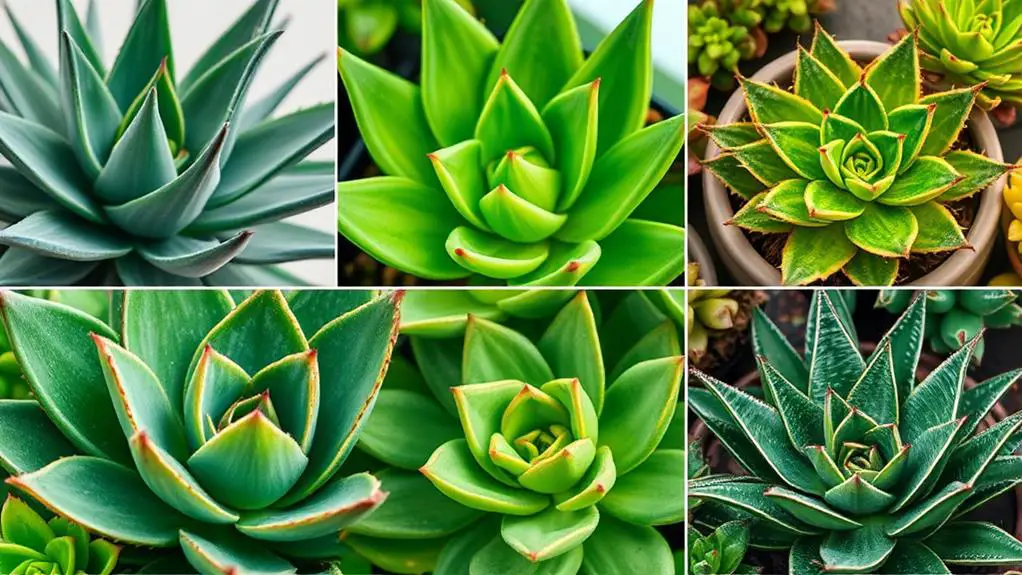
Succulents aren't just appealing for their unique aesthetics; they also offer a range of practical applications. Aloe, Agave, Gasteria, and Haworthia each have distinct uses that make them valuable beyond their beauty.
1. Aloe: Known for its medicinal properties, Aloe is perfect for soothing skin burns. Its rich antioxidant content makes it a popular ingredient in many cosmetics.
2. Agave: This plant is famous for producing tequila from Agave tequilana. Additionally, its fibers are used to make strong ropes and textiles.
3. Gasteria: This succulent is great for indoor spaces. It's low maintenance and can tolerate lower light conditions, making it a favorite for decorative purposes.
4. Haworthia: If you're into indoor gardening, Haworthia is an excellent choice. Its compact size and unique leaf structures are perfect for small spaces and collection displays.
All four types of succulents, including Aloe, Agave, Gasteria, and Haworthia, are valued for their drought resistance.
This makes them popular choices for xeriscaping and sustainable gardening practices. These succulents not only enhance your garden but also offer practical benefits, making them a smart addition to any home.
Identification Tips
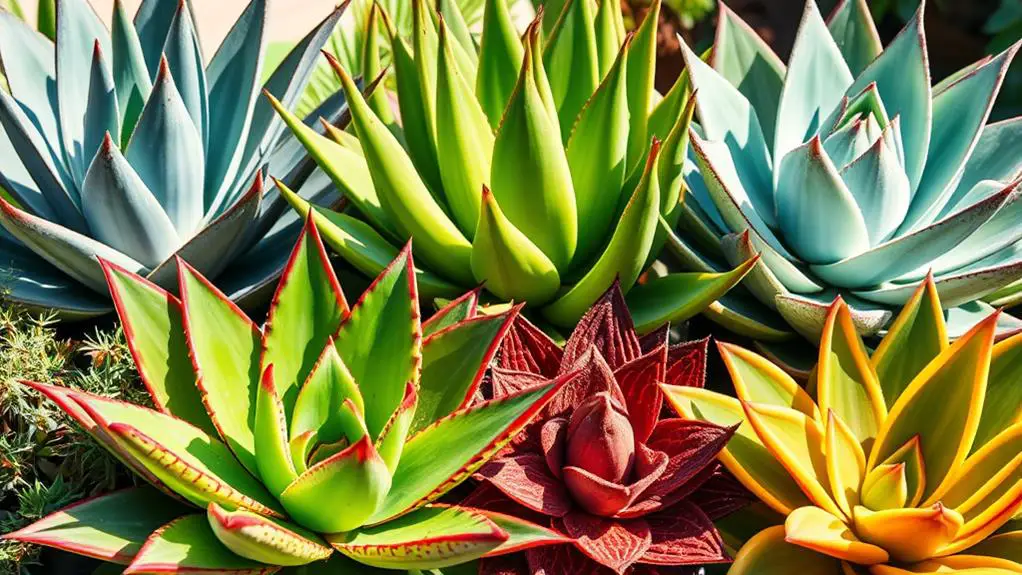
Recognizing different types of succulents requires a keen eye for detail and a bit of botanical knowledge. Start by observing the leaf shape, size, and color. Aloe plants have softer, fleshy leaves with prickly edges, making them stand out.
Agave, however, has larger leaves with sharp spikes, so be careful!
Try the snap test to identify different types. Snap an Aloe leaf, and you'll find a gelatinous, water-filled tissue inside. In contrast, snapping an Agave leaf reveals fibrous texture. This simple test works wonders in distinguishing them.
Gasteria is another unique succulent. Its long, thick, speckled leaves are easy to spot, and they don't have spikes, unlike Aloe and Agave. The lack of spikes makes Gasteria quite distinctive.
Haworthia, on the other hand, features small, rosetted, spoon-like leaves. They often have a pale green color with darker vertical stripes. These leaves are much thinner compared to Aloe and Agave.
Take note of blooming habits too. Aloe and Gasteria bloom annually, while Agave blooms only once after many years.
Frequently Asked Questions
What Is the Difference Between Haworthia and Aloe Haworthia?
You'll find that Haworthia has small, smooth-edged leaves and stays compact, perfect for indoor spaces. Aloe, on the other hand, has larger, prickly leaves, grows bigger, and contains medicinal gel. Both have unique blooming habits.
What Is the Difference Between Haworthia and Gasteria?
You can tell Haworthia and Gasteria apart by their leaves. Haworthia has small, smooth, translucent-tipped leaves, while Gasteria features thicker, speckled leaves with unique textures. Haworthia thrives in low light better than Gasteria.
How Do I Identify the Type of Succulent I Have?
To identify your succulent, check the leaf shape, texture, and margins. Conduct a snap test for Aloe and Agave. Observe for unique features like speckled patterns in Gasteria or stacked leaves in Haworthia.
How to Identify Haworthia Succulent?
You can identify a Haworthia by its small size, round, spoon-like leaves with smooth edges, and pale green color with darker vertical stripes. Look for adaptability to low light and bumpy white bands on some varieties.
Conclusion
Now that you know the differences between Aloe, Agave, Gasteria, and Haworthia, you're ready to start identifying them in your garden or home. Look for their unique leaf shapes, growth habits, and blooming patterns. Don't worry if it takes time; practice makes perfect. With patience and attention, you'll soon be a succulent expert. Happy gardening, and remember, every plant you care for helps you grow too! Keep learning and enjoy your succulent journey.

